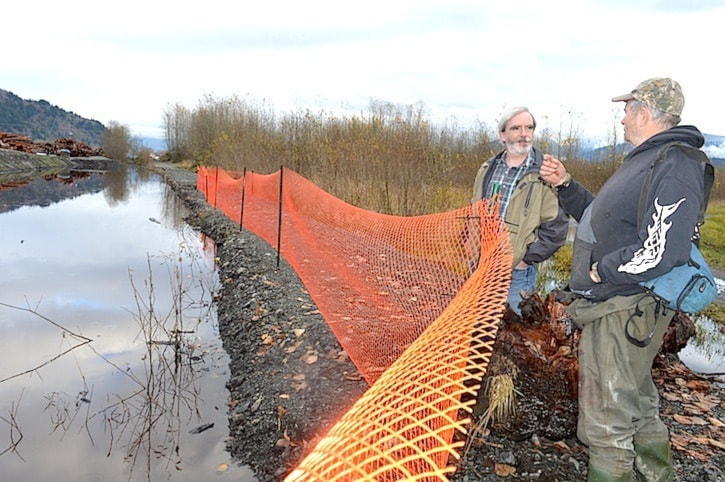Blackish water is running over the road from the old log sort at the end of Cannor Road.
A small stream of it is trickling into a ditch leading directly to the Fraser River.
The black runoff is leachate from wood waste and logs owned by Probyn Log Ltd., on the edge of the Fraser near Chilliwack.
The runoff has been an ongoing issue for the log sort but a new system devised by consultants is taking a science-based approach to dealing with it.
"The leachate, like wood-chip tea, has become the plague of the logging industry," explained Tim Weaver, environmental scientist and part owner of Enviro Chem.
 "Pretty well every log yard in B.C. has these runoff issues."
"Pretty well every log yard in B.C. has these runoff issues."
Weaver has been to more than 50 log sorts across the province, studying the challenge of wood waste leachate, and how to best neutralize it.
The blackness comes from "wood extractives," or naturally dissolved organic compounds like resins, which typically darken the longer they are exposed to air.
"It's not an indicator of toxicity," Weaver said.
That may seem a little counter-intuitive.
It's just an odd phenomenon, the scientist/consultant said, with tannic acid phenols reflecting light differently as they neutralize.
"The industry has always had this issue," he said. "The black colour gets them in trouble. People think it's hydrocarbons, but it's not the case."
Ian Stephen of Water Wealth Project started asking some questions after getting a citizen report about the black runoff at the log sort back in early 2014.
Some of the first reports said the black, oozy substance looked like diesel. APTN did a segment on it.
 Stephen returned to the site last week, concerned that the black runoff was still visibly present. He'd so far filed access to information requests, made reports and inquiries to various authorities about the black leachate, which according to MoE in 2014, at 100% concentration, was lethal to fish at the four-hour mark.
Stephen returned to the site last week, concerned that the black runoff was still visibly present. He'd so far filed access to information requests, made reports and inquiries to various authorities about the black leachate, which according to MoE in 2014, at 100% concentration, was lethal to fish at the four-hour mark.
So when waste water is leaving the site and believed to contain toxic elements, the regulators like Environment Canada will conduct a test.
Then it's pass or fail to find out if it will kill fish, because the law dictates that they can't allow deleterious substances to enter waterways.
Tests at the log sort in 2014 showed "significantly higher" than the provincial limits for resin acids, according to documents obtained by Stephen under the Access to Information Act.
Officials at Environment Canada ordered the company, which at the time they were dealing with Southview Sort, to "develop and implement" a plan to "prevent the deposit of deleterious substances into waters frequented by fish" generated from the property.
Recently the site has been transformed.
"The work to build the berm around the paved part of the property and to enlarge the ditch was relatively recent and clearly done at some expense, so it seems the company is trying," noted Stephen. "But there is still black leachate flowing into the stream within the wildlife management area and into the Fraser River."
But he also sees a systemic issue with reporting to provincial or federal authorities. It took months and months to get any answers.
"The overarching problem this particular issue brings to light seems to me to be that there is not sufficient follow-up by agencies to ensure that a problem is fixed, leaving it to individual citizens to make complaints again," said Stephen.
"However, individual citizens are not privy to what has or is occurring between agencies and polluter so do not know whether complaint is warranted or whether corrective action is still to come or underway," Stephen said.
Followup should be more fluid, and greater transparency is needed, he said.
The crux of the problem, according to Weaver, is that many log yard operators are well meaning and want to address these issues.
The government regulators, acting on complaints, order them to "fix" the problem with their runoff, but they don't explain or really know how to do it effectively, he posited.
Recent research and testing has showed Enviro Chem officials precisely what to do. They use organisms to biodegrade the tannins, or wood extractives.
Probyn Log reps took the matter firmly in hand last winter, hiring consultants Enviro Chem, according to Matthew Brine, a forester with Probyn Log Ltd..
"We know it's concerning to see the black water — the colour and the smell of it — but we've done a lot of work to remedy it," Brine said.
They are a few weeks away from project completion.
They'll be doing final testing of a new aeration system, seeded with sludge that pulp mills use, full of bacterial organisms to eat the particulate matter, and clean the water further.
"Once it's fully operational with aeration and the organisms being introduced, that water, while still black, will be cleaner," said Brine.
The aeration is in addition to Probyn officials having the entire site paved to help move the water off of it more efficiently. They also built a pond-like catch basin with lava-rock walls to filter out particulates, and oil/water separators that offer added filtration.
Getting that information out to the public and local dog-walkers who pass by, "would be nice," Brine told The Progress.
They're going to substantial effort and expense to fix it, without providing an exact dollar figure on the total project cost.
"This is our last push to ensure the water is really clean and can support the habitat there.
While we can't take the colour out of it completely, and we can't make it glacier water, we can make sure it's non-toxic."

